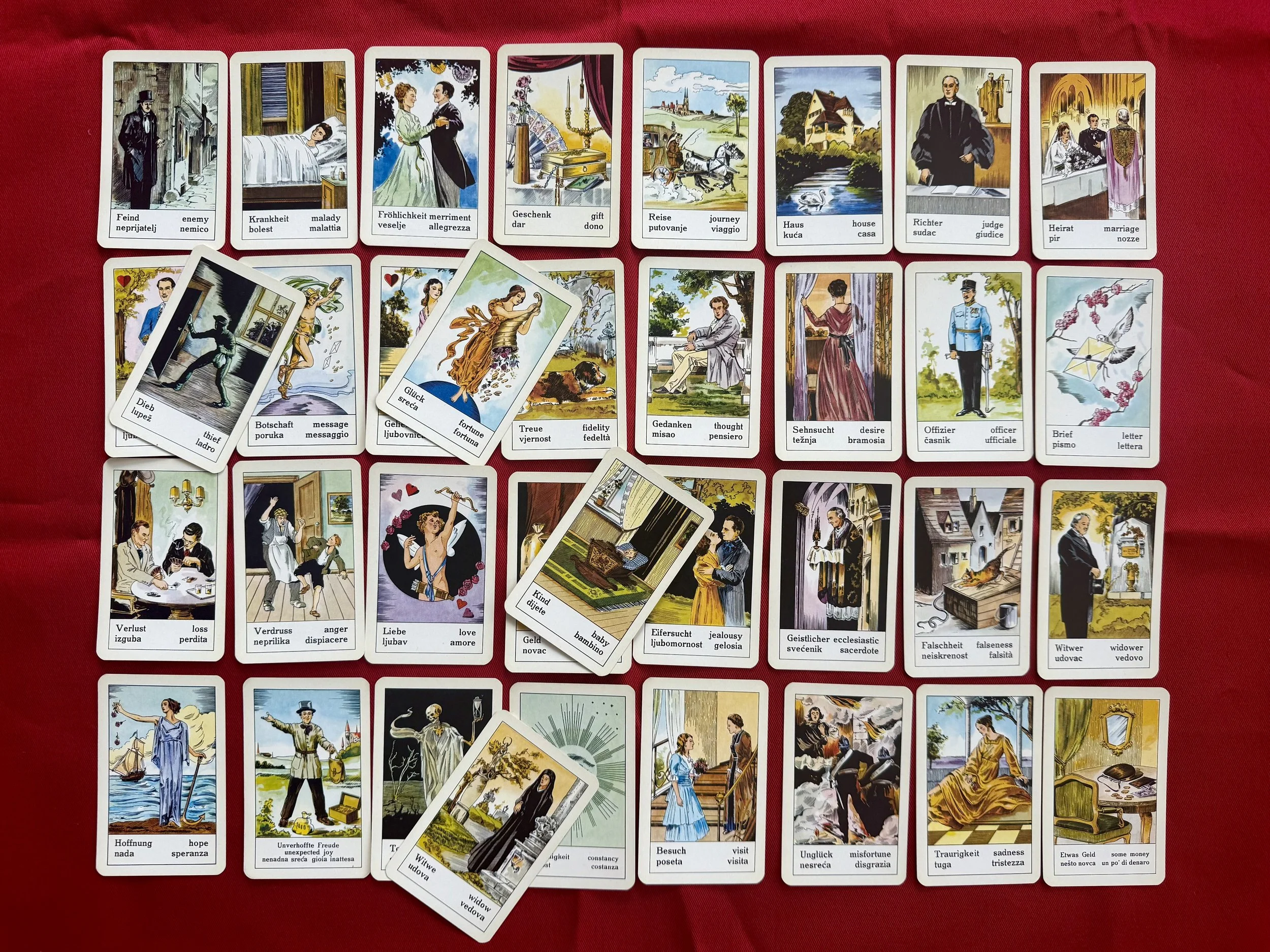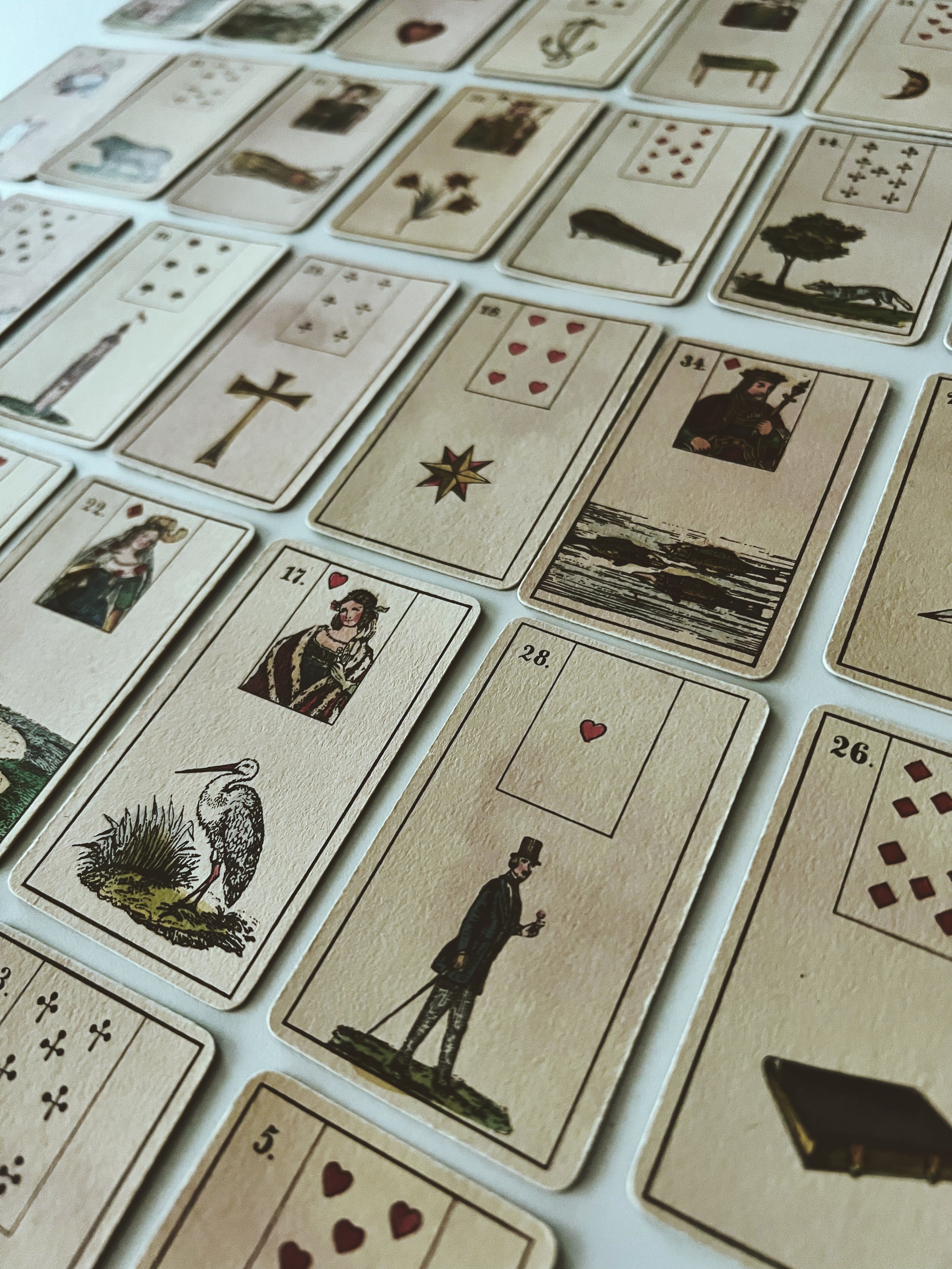The Art of the General Reading: A Tableau With Gypsy Fortunetelling Cards
Many cartomancers in the English-speaking world are unaware that most spreads used today are much more recent inventions than they are made out to be. I often encounter readers who still believe the Celtic Cross is an ancient spread, unaware that it was popularized by Arthur Edward Waite in the early 20th century. His claim that it was of ancient origin has never been substantiated. Meanwhile, fortunetellers across Europe continued reading cards as they always had—unconcerned with what the self-promoting occult elite in Britain and the US were proclaiming as the immutable laws of cartomancy.
Card reading methods in Western, Eastern, and Central Europe made no pretensions to ancient origins, nor did they need to. Cartomancy as we know it largely developed in the Early Modern Period (Elias, 2019). It took shape in the 18th and 19th centuries, particularly in the parlors of the rising bourgeoisie, from which it spread into broader popular use, especially among folk magicians and professional fortunetellers. The dominant method was the tableau-laying (almost) all cards on the table at once. The standard tool was the 32-card Piquet deck. Later, the Lenormand and Aufschlagkarten decks (the latter eventually known as Gypsy Fortunetelling Cards) appeared in the 19th century (Pitts, 2022), adopting nearly identical reading techniques. In the case of the Lenormand deck, this lineage is visually evident in the small playing card insets.
The tableau was well suited for the common situation in which clients were reluctant to reveal their true concerns. A general reading offered a panoramic view of their situation - enough to provoke recognition, build trust, and eventually prompt the client to share what they really wanted to ask. In one glance, the reader had a map, and the story could unfold from there.
Since many of you have expressed interest in the Gypsy Fortunetelling Cards and their traditional use in the Balkans, I decided to present a general reading tableau method I was taught as a child - one I still enjoy using. Like any tableau, it can be tailored to specific questions, which I always recommend. However, its primary purpose was to impress. Winning over a client’s skepticism was the first hurdle, and delivering a spot-on general reading served as a seal of legitimacy for the fortuneteller. Serbian fortunetellers would go so far as to say: the less you know about the client, the better. This principle guards against the risk of subjective interpretation distorting the cards’ message. It also underpins the old belief that one should never attempt to predict the future of a loved one, for that very reason.
The Method
The following is just one of several traditional tableau layouts. It’s structured around temporal progression, allowing the reading to unfold as a linear story.
The session begins by asking the client to make a wish—a standard step in many Balkan fortunetelling practices. The wish must remain unspoken, as voicing it is believed to prevent its fulfillment. After that, the fortuneteller shuffles and cuts the deck, reading the two bottom cards to assess the outcome of the wish. In practice, these cards often reveal the client’s true intent, serving as an anchor for the rest of the reading.
The tableau is laid out in four rows of eight cards, with the remaining four cards left unturned and set aside. The rows are interpreted as follows:
First row: the client’s past
Second row: the present
Third row: near-future developments
Fourth row: what is fated, or the final outcome
Once the rows have been interpreted, the four leftover cards can be used to cover specific cards of interest - for example, the significator (Lover/Sweetheart), the Money card, or Malady in cases of health inquiries. These additional cards offer clarification or nuance.
The placement of the significator is especially important. The row it appears in indicates the area where the client has the most agency. If it lands in the first row, the client has already dealt with the issue and is (quite literally) on top of things. If it appears in the fourth row, they feel overwhelmed or dominated by fate. If the significator doesn’t appear at all, then the client currently lacks agency in their situation - circumstances are steering the course. Let us look at an example.
1960s edition of Piatnik’s Gypsy Fortunetelling Cards. From my private collection.
In this reading, the significator (Sweetheart) appeared in the second row, representing the present. She is facing her situation head-on and is firmly anchored in the moment. The Fortune card appears over her, suggesting she feels content in her current stance, specifically because she has chosen to turn her back on a man who was all talk and no substance (Lover next to Message, covered by Thief). She has already become infatuated with someone new - a colleague (Fidelity, Thought, Desire, Officer, clarified by Judge and Letter). As you can see, I freely incorporate cards from different rows when I observe clear influence, always guided by plausibility and internal coherence.
As with any reading method, there is no rigid canon to follow. Feel free to experiment: add counting methods, introduce new steps in your parlor sequence, or adapt the flow as suits your style. That said, I encourage you to settle on a structure that feels natural and stick with it. Reinventing your approach with each reading rarely leads to clarity. And let me repeat one thing: a reading worth anyone’s time pays attention to context and builds a coherent narrative. “I see Money, therefore you’ll gain money” is not just vague - it’s dull. It wastes the querent’s time. So let your readings flow with purpose and precision - like a mountain stream, smooth and clear.
References
Elias, C. (2019) Divination with Cards: A Short History. Eye Corner Press: Agger, Denmakr.
Pitts, R. (2022) Austrian Cartomancy Cards. From ‘The World of Playing Cards’ website. Viewed on May 16, 2025. Link: https://www.wopc.co.uk/tarot/cartomancy-oracle-and-divination-cards/austrian-cartomancy-decks
Curious to see what a tableau reading can reveal about your own situation?
I offer personalized readings using the traditional tableau method with the Gypsy Fortunetelling Cards, Lenormand, or Playing Cards.
No vague platitudes - just clear, contextual insight.




